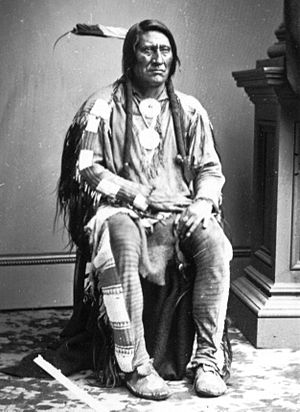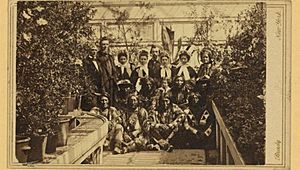Lean Bear facts for kids
Lean Bear (whose Cheyenne name was Awoninahku, born in 1813 and died in 1864) was an important Cheyenne peace chief. He was also known as Starving Bear. He was a member of the Council of Forty-four, a special group of leaders who worked to keep peace with the American settlers moving into their lands.
Lean Bear is remembered for his efforts to make peace. These included signing the Fort Wise Treaty and meeting with U.S. President Abraham Lincoln. Sadly, his work for peace between his people and the American settlers in the Southern Plains ended when he was killed by soldiers from the 1st Colorado Cavalry Regiment. His death led to more fighting.
Contents
About Lean Bear
Lean Bear had a brother named Bull Bear. In 1864, Bull Bear became a leader of the Dog Soldiers. This was a group of Cheyenne warriors who often disagreed with the peace chiefs. Lean Bear also worked closely with another peace chief, Black Kettle. They served together on the Council of Forty-four for many years.
Working for Peace
One of the first stories about Lean Bear happened in 1851. He was about 35 years old. An agent named Thomas Fitzpatrick held a meeting at Fort Atkinson. He wanted to convince different Plains tribes, like the Comanche, Kiowa, Apache, Arapaho, and Cheyenne, to attend a bigger peace meeting later.
Lean Bear was at this meeting. He was very interested in the rings and bracelets on the hand of Colonel Sumner's wife. When he reached out to get a closer look, she pulled her hand back and screamed. Colonel Sumner then tried to hit Lean Bear. In Cheyenne culture, hitting someone, even a child, was a big insult. Lean Bear was very upset. He painted his face and announced he would attack the white people.
Later, a meeting was set up for Colonel Sumner to apologize to Lean Bear by giving him a blanket. Lean Bear accepted the apology.
The Council of Forty-Four
Lean Bear was chosen by older chiefs to join the Council of Forty-four. This council chose its own new members. The council's main goal was to encourage their people to live peacefully with the Americans. When someone became a chief in this council, they had to leave any warrior groups they belonged to.
However, another group called the Dog Soldiers grew stronger. They were Cheyenne warriors who did not want to cooperate with white settlers. They often stole animals and fought with soldiers and settlers. The Dog Soldiers were even considered outcasts by some Cheyenne. But their actions often caused problems for the peace-seeking Cheyenne chiefs like Lean Bear.
The Treaty of Fort Wise
In October 1857, Chief Lean Bear and three other Cheyenne chiefs spoke to William Bent. They were worried about attacks on their people by soldiers. Bent then sent a letter to Washington D.C. for them.
In 1860, a government official met the chiefs at Fort Wise. Chief Lean Bear was one of the main signers of the Fort Wise Treaty in 1861. This treaty was made with Cheyenne and Arapaho chiefs. It took away about 40 million acres of land from their territory.
Not everyone agreed with this treaty. The Dog Soldiers were especially angry. Only six Cheyenne chiefs signed the treaty, but usually all forty-four chiefs were needed for important agreements. The treaty was meant to keep peace as settlers moved closer to Indian lands. But losing so much land and the continued arrival of white settlers only made things worse. The Cheyenne people did not want to be forced onto a small reserve where there were not many buffalo.
Meeting President Lincoln
On March 27, 1863, Lean Bear was part of a group of chiefs and two women who met with President Abraham Lincoln at the White House. This meeting happened because there were fights between Native tribes and white settlers. Lincoln hoped to convince the Southern Plains tribes to either join the Union (the North) or stay neutral in the American Civil War.
Lincoln welcomed the chiefs. He talked about how much land and wealth white Americans had gained. Lean Bear asked the president to stop his white Americans from being violent. He wanted both Native Americans and white people to be able to travel safely across the plains.
Lincoln told the chiefs that Native people would need to learn to farm like the white settlers to be successful. He also asked the Southern Plains Indians to stay neutral in the Civil War. He offered peace medals to those who agreed. The chiefs promised to keep their peace treaties and not join the Confederacy (the South). Lean Bear then asked the president to help them return home quickly.
Lean Bear's Legacy
There are no confirmed photos of Lean Bear himself. The only pictures are of the entire room when the chiefs met President Lincoln in 1863. People have different ideas about who each chief in the picture is. However, one image of a Cheyenne peace chief is often believed to be Lean Bear.
Some parts of Lean Bear's life are shared in a book of stories called By Cheyenne Campfires. This book was put together by George Bird Grinnell.



